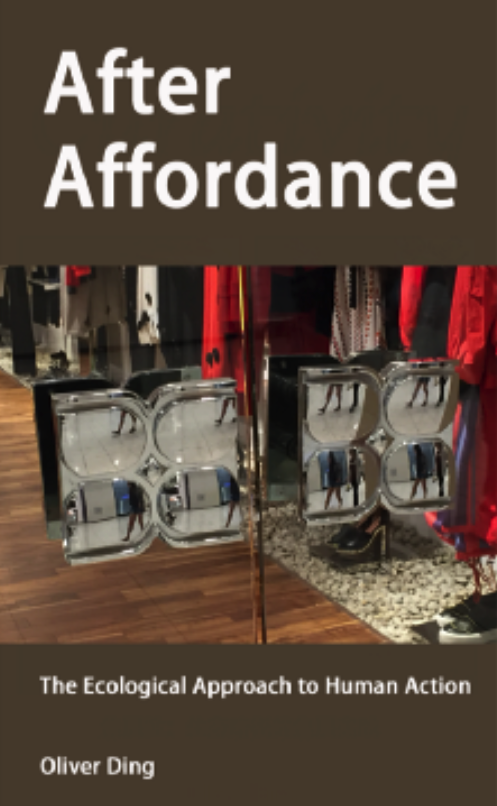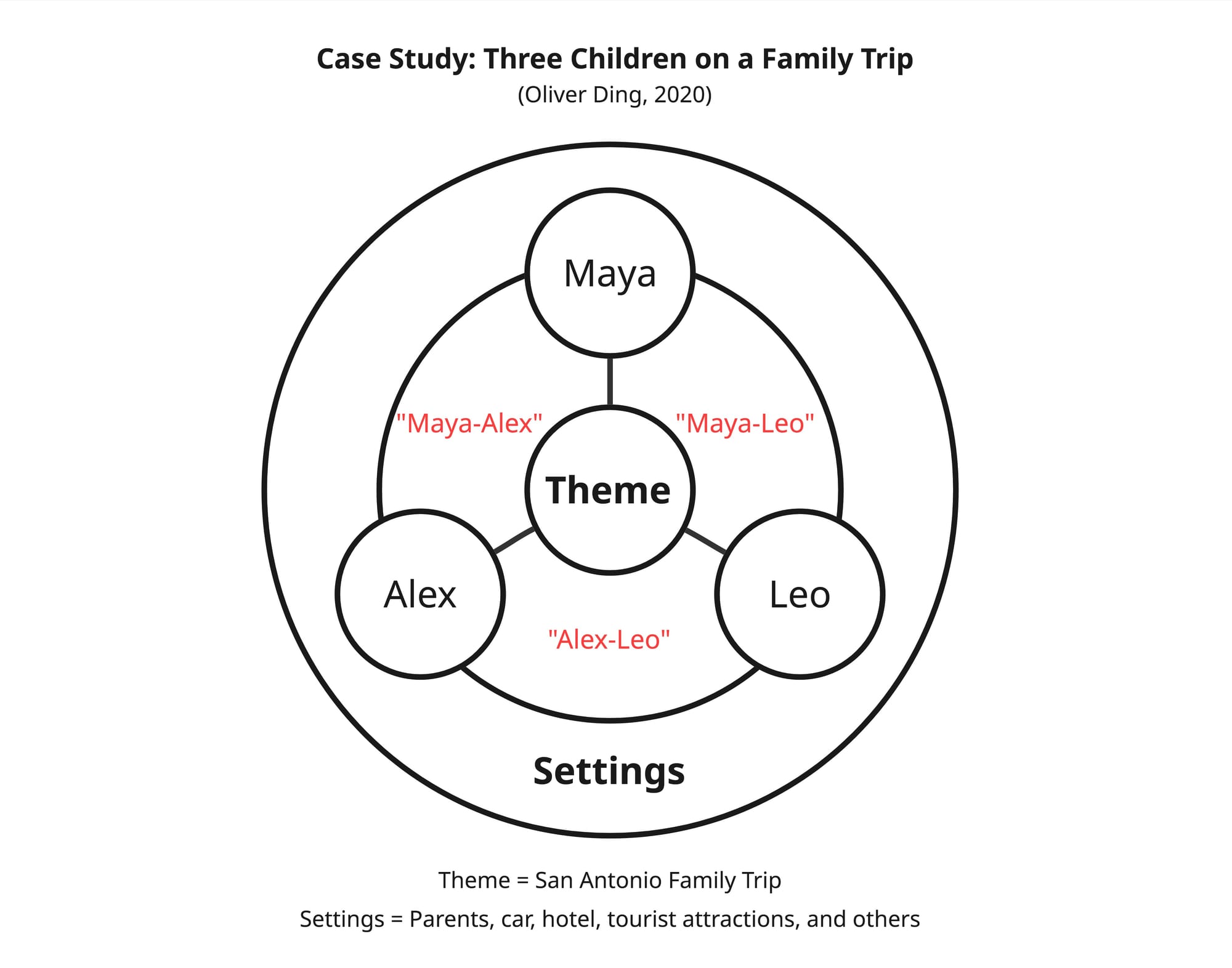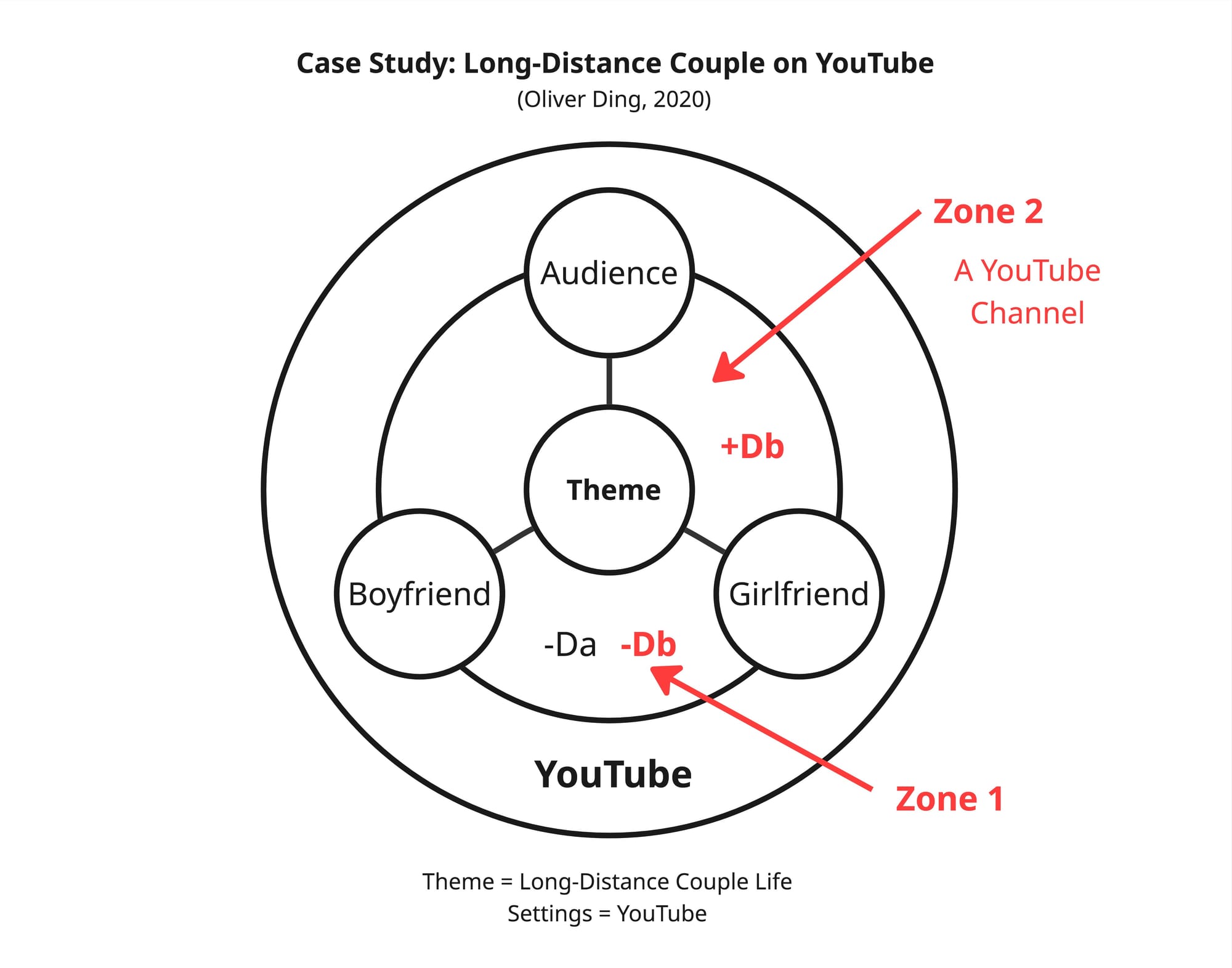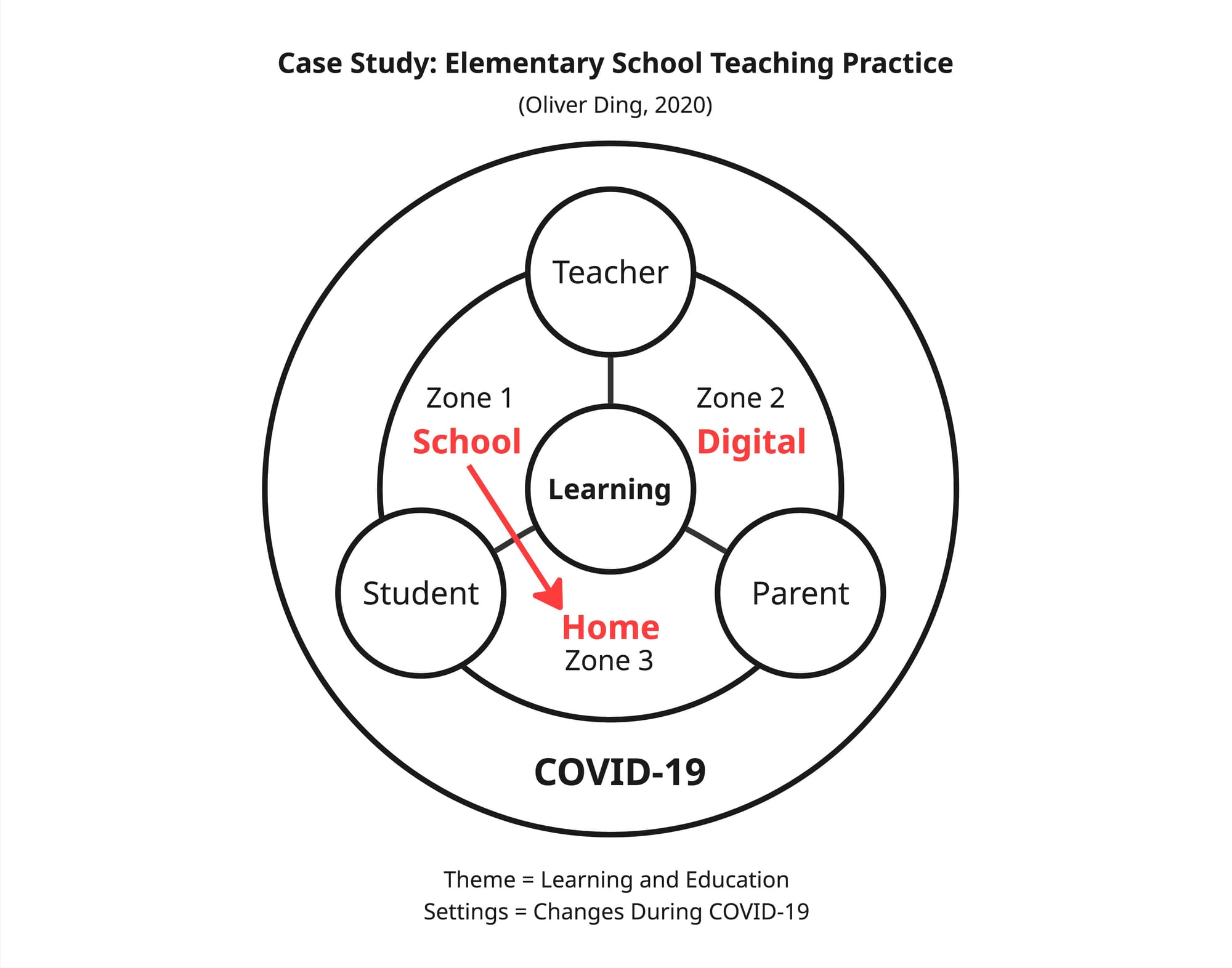The Ecological Camp Framework (2018)

An Ecological Approach to Triadic Social Interaction
by Oliver Ding
This article is an excerpt from my 2020 Chinese book draft After Affordance: The Ecological Approach to Human Action, translated into English with AI assistance.

In 2018, I developed the Ecological Zone Framework to highlight a new theoretical creative space for an ecological approach to social interaction. The term "Ecological Zone" refers to an interactive space between two subjects engaged in a shared activity of short or long duration.
The basic model of the Ecological Zone Framework represents a dyadic structure.

This model does not provide a conventional account of intersubjectivity, as my focus is on ecological aspects. My goal is to introduce a layer bridging Gibson's Affordance Theory and Barker's Behavior Settings Theory, drawing also on Gibson's idea of the Ecological Self.
One key ecological aspect of the framework is Ecological Force. The term "Force" is inspired by Lewin's topological psychology; however, my use of Ecological Force emphasizes the source of the force itself. I focus on the ecological origin rather than individual perception. For example, consider Distance as an ecological force:
- -Da: Negative impact of Distance perceived by Person A
- -Db: Negative impact of Distance perceived by Person B
Here, D refers to Distance, which is considered an ecological force in the context of the Ecological Zone. Distance exists as a fact between two people; if only one person is present, there is no Distance. The existence of Distance depends not on either person individually, but on their relative positions.
Suppose the shared activity is a remote work project in which Distance is a significant ecological force. Person A perceives a negative impact from this Distance, represented by the sign "-Da." Similarly, "-Db" represents a negative impact perceived by Person B.
Individual differences may result in Person B perceiving a positive impact from the same Distance. Moreover, Distance is only one type of ecological force; different activities involve various ecological forces.
The Camp Level: Tripartite Structure
I typically apply the framework with at least three zones, which is called the Camp level. While the dyadic model represents the basic building block, the Camp level of the Ecological Zone Framework represents the standard usage and embodies its unique theoretical value.

While I have employed the Zone-level analysis in various other projects, the Camp-level analysis method more profoundly demonstrates what distinguishes the ecological perspective from other intersubjective analytical frameworks. The Camp level reveals how multiple dyadic relationships interact within a shared context, allowing us to examine not just isolated pairs but the dynamic interplay among three or more subjects. This article uses the Ecological Camp Framework to demonstrate this analytical approach through three concrete case studies.
There are four key concepts for understanding a Camp:
- Structural Distinctions: Since the three subjects each have their own identities, positions, and motivations, structural distinctions exist between the three Zones.
- Situational Dynamics: Individual differences among members of each Zone shape interactions. Real interactions occur between real people, giving rise to situational dynamics within each Zone.
- Themes of Practice: To curate diverse experiences of daily interactions, I adopt this concept from Curativity Theory. A Theme of Practice refers to a set of interactions sharing a common issue, agenda, or theme.
- Boundaryless Echoes: Each subject experiences each Zone differently, with experiences that may be positive or negative. To cope with negative experiences in one Zone, a subject can draw on positive experiences from other Zones or curate interactions from different Zones with similar Themes of Practice.
To illustrate how the Ecological Camp Framework operates in practice, I present three case studies that demonstrate its analytical power across different contexts: family interactions during travel, digital platform dynamics, and educational settings during crisis.
These cases showcase the concrete analytical methods of applying the framework, enabling readers to adapt and apply it to their own contexts.
Case 1: Three Children on a Family Trip
The diagram below uses "Three Children on a Family Trip" as a case study to demonstrate the specific analytical method at the Camp level.

Background
In summer 2019, my young nephew and mother-in-law came to the United States for a visit. In early July, we left Houston for a trip to San Antonio. We rented a car for six people: my wife and I, our two children, plus two guests—the nephew and mother-in-law.
Note: To protect the children's privacy, I use pseudonyms throughout this case study. Our two children are six-year-old Leo and eight-year-old Alex. The nephew from mainland China is nine-year-old Maya.
In the diagram, the three subjects are Maya, Alex, and Leo. The Theme of Practice is "San Antonio Family Trip." The background Settings include parents, car, hotel, tourist attractions, and others.
In this diagram, there are three Zones: "Maya-Alex," "Maya-Leo," and "Alex-Leo." Everything that happened among these three Zones during the entire "San Antonio Family Trip" can be represented in the diagram.
Detailed Analysis: Minecraft Discussion in the Car
For specific single events, this diagram can also be used for in-depth analysis. For example, during the entire "San Antonio Family Trip," these three children did one thing: they discussed the Minecraft game while riding in the car. I drew a new Camp diagram specifically for this event.

The drive between Houston and San Antonio takes three and a half hours. On the way from Houston to San Antonio, Alex and Leo conversed in English about Minecraft the entire time. Maya couldn't understand what they were saying and felt anxious on the sidelines. On the return trip from San Antonio to Houston, Maya requested to join the discussion, so Alex switched to Chinese to communicate with him. The conversational subjects became Maya and Alex.
In this discussion case, the background Settings are simplified to "parents, car."
The Camp Level Analysis Characteristic: It places multiple Zones together, making it possible to examine the relationships between different Zones.

Symbols and Forces Analysis
The diagram above adds some symbols to the previous one: Zone 1, Zone 2, -La, +Lb, +Lc. What do these symbols mean?
According to previous symbol explanations:
- Zone 1 represents the Zone between "Alex-Leo"
- Zone 2 represents the Zone between "Maya-Alex"
The three subjects are coded as a, b, and c, which in this case are: a=Maya, b=Alex, c=Leo
- L represents Language as a "Force"
- -La represents the negative experience that the Force of language brings to Maya
- +Lb represents the positive experience that the Force of language brings to Alex
- +Lc represents the positive experience that the Force of language brings to Leo
The diagram marks with red arrows the direction of movement from Zone 1 to Zone 2. In this case, the focus on the outbound journey was on Zone 1, with most conversations occurring in the "Alex-Leo" Zone, where they discussed Minecraft in English. Maya, due to insufficient English proficiency, was affected by the Force of language, resulting in a negative experience (-La). In fact, Maya was quite familiar with and knowledgeable about Minecraft, possessing the knowledge foundation to participate in the discussion.
On the return trip, Maya requested to discuss Minecraft in Chinese. Alex accepted this proposal and switched to discussing Minecraft with Maya in Chinese. At this point, the focus of the return trip shifted to Zone 2, the "Maya-Alex" Zone. By requesting a language change, Maya eliminated the negative impact of the language Force. His knowledge and skills about Minecraft as a Force brought him positive influence. Meanwhile, as Alex's attention shifted to Zone 2, his investment in Zone 1 was no longer as high, and Leo consequently faded from the entire conversation, turning instead to reading books and doing other things on his own.
Case 2: Long-Distance Couple on YouTube
Camp analysis can be applied not only to physical environment interpersonal interactions but also to digital environment interpersonal interactions. The diagram below illustrates the "Long-Distance Couple on YouTube" case.
Background
YouTube.com is currently the world's most influential video-sharing website. Many individuals share videos of their daily lives on the site. Some of these individuals are couples living in different locations. I read about how long-distance couples use the YouTube website in a paper on YouTube user behavior, so I analyzed it using the Camp framework.

Analysis Structure
According to the Camp diagram and symbol explanations, in this case:
- The three subjects are: boyfriend = a, girlfriend = b, audience = c
- The Theme of Practice is "Long-Distance Couple Life"
- Assume the girlfriend opened the YouTube.com user account
We can see two Zones:
- Zone 1: Between "boyfriend-girlfriend"
- Zone 2: Between "girlfriend-audience"
Force Analysis
In Zone 1: The two live in different locations. Distance brings them negative impacts:
- -Da represents the negative impact distance brings to the boyfriend
- -Db represents the negative impact distance brings to the girlfriend
In Zone 2: The girlfriend plays the role of vlog host, sharing the long-distance couple life brought about by distance. At this time, the long-distance life becomes a special genre of video content, attracting some audiences interested in this topic. The advertising revenue from these video programs can be used to subsidize the long-distance couple's transportation costs, facilitating more reunion opportunities. In Zone 2, distance brings a positive experience to the girlfriend (+Db).
Key Insight
Camp analysis transcends the limitations of single-zone analysis by examining multiple Zones together, providing a more comprehensive and in-depth view. In the "Three Children on a Family Trip" case, we saw that subjects take proactive actions to eliminate negative experiences by changing behavior patterns, thus causing dynamic changes in different Zones. In the "Long-Distance Couple on YouTube" case, we see that the same Force—"distance"—presents different impacts in different Zones, where the negative impact of one Zone can be offset and balanced by the positive impact of another Zone.
Case 3: Elementary School Teaching Practice (Teacher-Student-Parent)
Structure
In elementary school teaching practice, the "teacher-student-parent" relationship forms a ternary structure. The diagram depicts three "Ecological Zones" existing in this ternary structure.

Context: Changes During COVID-19
The diagram describes changes in elementary school teaching practice in the Houston Independent School District (HISD) during the COVID-19 pandemic in 2020. My children attended an elementary school in HISD, and I gained these insights while accompanying them in at-home schooling during that period. Therefore, these changes are limited to the HISD situation at that time.
Zone 1: Teacher-Student
The ecological zone between teacher and student is Zone 1. The spatial and temporal distribution of information and action in this Zone 1 was very regular. Before the COVID-19 pandemic, it was spatially centered on schools and classrooms, and temporally focused on weekday daytime hours. After the COVID-19 pandemic occurred, the spatial and temporal distribution of information and action in Zone 1 changed.
Zone 3: Student-Parent
The ecological zone between student and parent is Zone 3. The spatial and temporal distribution of information and action in this Zone 3 was equally regular. In spatial distribution, it was mainly centered on home, with other locations including schools, off-campus learning spaces, community outdoor parks, and museums. Temporally, it focused on winter and summer vacations, weekends, and early morning and evening hours during school days from Monday to Friday. After the COVID-19 pandemic, students studied at home, making home an important spatial location, with more time spent at home.
Zone 2: Teacher-Parent
The ecological zone between teacher and parent is Zone 2. The spatial and temporal distribution of information and action in this Zone 2 was equally regular. In spatial distribution, it emphasized digital tools—teachers contacted parents through text messages, email, the Remind mobile app, and the ClassDojo mobile app. Additionally, parents occasionally participated in classroom activities at school, communicating face-to-face with teachers.
Temporally, it mainly focused on weekday daytime hours. After the COVID-19 pandemic began, spatial distribution relied even more on digital tools, with Google Classroom replacing the Remind and ClassDojo mobile apps as a more important interaction channel.
Key Shift in Focus
After the COVID-19 pandemic began in 2020, HISD stopped traditional campus teaching activities and adopted at-home learning instead. At this point, the focal points of the three ecological zones shifted:
- Before COVID-19: School was the primary Spot among the three ecological zones, and daily teaching practice heavily relied on the physical environment space of classrooms.
- After COVID-19: Home became the primary action Spot among the three ecological zones, digital space became the secondary main action Spot, and schools instead became auxiliary action Spots.
Relationship to Project Engagement Approach
The Ecological Camp Framework complements and extends the Project Engagement approach, particularly version 3.1 developed in May 2024. While Project Engagement provides a comprehensive theoretical toolkit for understanding project-oriented social ecology—including frameworks such as the Developmental Project Model, the Social Landscape Framework, and the Thematic Identity Curation Framework—the Ecological Camp Framework offers a focused analytical method for examining specific interpersonal dynamics within project contexts.

The Camp-level analysis proves especially valuable for exploring several thematic rooms in the House of Project Engagement: Meet with Others (examining how project participants navigate multiple relationships), Settings (understanding how environmental configurations shape interactions), and Conflict (analyzing how tensions emerge and are managed across different Zones).

By providing systematic tools for mapping and analyzing tripartite relationships, the Ecological Camp Framework can serve as an additional analytical framework within the Project Engagement family, bridging the gap between individual project roles and larger network structures.
Conclusion
The three case studies presented in this paper demonstrate the analytical power of the Ecological Camp Framework. Through examining tripartite relationships—whether among children on a family trip, a long-distance couple with their online audience, or teachers, students, and parents in educational settings—the Camp-level analysis reveals dynamics that would remain hidden in conventional dyadic approaches.
Several key insights emerge from these cases:
1. Zone Dynamics and Force Analysis: The concept of Ecological Forces (such as Language in Case 1 and Distance in Case 2) provides a concrete way to understand how environmental and relational factors shape interactions. Crucially, the same force can produce different effects across different Zones, as we saw with Distance creating negative experiences in one Zone while generating positive opportunities in another.
2. Adaptive Strategies Across Zones: Subjects actively navigate their multi-zone environments. Maya's request to switch languages in Case 1 exemplifies how individuals can modify one Zone to reduce negative experiences. The YouTube couple in Case 2 demonstrates how participants can leverage positive experiences in one Zone to offset challenges in another—a phenomenon we term "Boundaryless Echoes."
3. Contextual Shifts and Structural Changes: The COVID-19 case study illustrates how external events can fundamentally restructure the focal points within a Camp. The shift from school-centered to home-centered learning redistributed the weight and importance of the three Zones, demonstrating that Camps are not static structures but dynamic systems responsive to changing conditions.
4. Scale Appropriateness: Camp-level analysis proves most suitable for examining groups of two to approximately a dozen participants. For larger communities or platforms, the framework extends to the concept of ba, which addresses analysis at greater scales involving dozens or hundreds of participants.
The Ecological Camp Framework bridges individual-level affordance theory and community-level behavior settings theory by providing a mid-range analytical unit that captures the complexity of small-group social interactions. By mapping multiple simultaneous relationships and tracking how subjects navigate between them, the framework offers researchers and practitioners a systematic method for understanding the ecological structure of everyday social life.
Future applications of this framework might examine professional collaboration networks, family systems in transition, or online community dynamics—any context where understanding the interplay among multiple dyadic relationships proves essential to grasping the whole interactive ecology.
V1 - 2020
V2 - November 14, 2025 - 2,671 words
